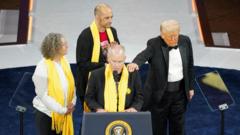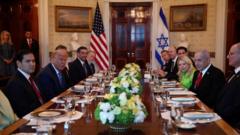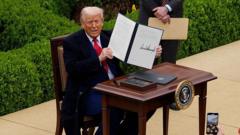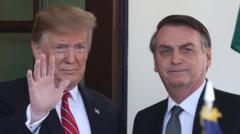As President Trump unveils new tariffs on vital trade partners, the economic landscape shifts, prompting concern among investors and government officials.
Trump's New Tariff Policy Seizes Attention: 25% Levies on Key Allies

Trump's New Tariff Policy Seizes Attention: 25% Levies on Key Allies
President's announcements rattle markets and deepen trade tensions with Japan and South Korea
In a bold move, President Trump announced a significant 25 percent tariff on goods exported from Japan and South Korea, effective August 1. This decision comes alongside an extension of previously planned increases on tariffs against other nations, causing a notable dip in market confidence as investors react to this intensifying trade conflict.
The tariff announcements were shared via several posts on social media, where Trump detailed additional tariff rates: a staggering 40 percent on Myanmar and Laos, a 30 percent increase for South Africa, and 25 percent for both Kazakhstan and Malaysia. The full extent of these tariffs is alarming for many, particularly given the uncertain trajectory of ongoing trade negotiations.
The Trump administration has been actively engaged in trade discussions with multiple nations for the past three months. While preliminary agreements have been reached with the UK and Vietnam, discussions with economic powerhouses Japan and South Korea have faced setbacks. Delays are attributed to recent elections in both countries, alongside ongoing trade threats from the Trump administration that have left these nations wary of future engagements.
The hesitation from both Japan and South Korea largely stems from a fear of further tariffs that could be levied against their major exports, such as automobiles, steel, and electronics. As negotiations stall, these new tariffs might complicate any path toward mutually beneficial trade agreements.
For further insights, review Trump's recent correspondence with South Korean President Lee Jae Myung, detailing strategic tariff discussions moving forward.
The tariff announcements were shared via several posts on social media, where Trump detailed additional tariff rates: a staggering 40 percent on Myanmar and Laos, a 30 percent increase for South Africa, and 25 percent for both Kazakhstan and Malaysia. The full extent of these tariffs is alarming for many, particularly given the uncertain trajectory of ongoing trade negotiations.
The Trump administration has been actively engaged in trade discussions with multiple nations for the past three months. While preliminary agreements have been reached with the UK and Vietnam, discussions with economic powerhouses Japan and South Korea have faced setbacks. Delays are attributed to recent elections in both countries, alongside ongoing trade threats from the Trump administration that have left these nations wary of future engagements.
The hesitation from both Japan and South Korea largely stems from a fear of further tariffs that could be levied against their major exports, such as automobiles, steel, and electronics. As negotiations stall, these new tariffs might complicate any path toward mutually beneficial trade agreements.
For further insights, review Trump's recent correspondence with South Korean President Lee Jae Myung, detailing strategic tariff discussions moving forward.


















